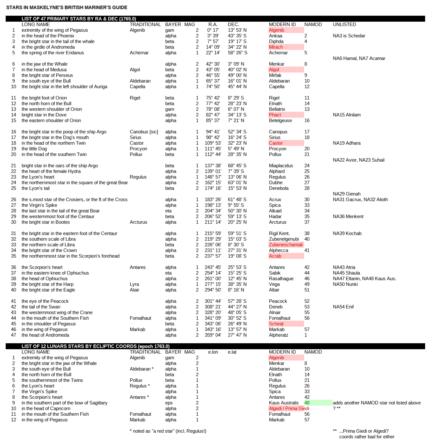
NavList:
A Community Devoted to the Preservation and Practice of Celestial Navigation and Other Methods of Traditional Wayfinding
From: Frank Reed
Date: 2024 May 17, 08:49 -0700
In Maskelyne's "British Mariner's Guide" published in 1764 there are two lists of stars. One is a list of stars for shooting lunars, which has some quirks, and there is also a general list of 47 bright stars useful to navigators, comparable to the list of 57 in the modern Nautical Almanac. There have been many lists of navigation stars in the past three hundred years or so. This one deserves a little attention since the source is the (soon to be) Royal Astronomer. Rather than try to format it as plain text or upload a spreadsheet, which many of you might find problematic, I've made an image of the spreadsheet table I put together from the original. See below.
Some things I noticed:
- There is significant overlap between Maskelyne's 47 and the modern Nautical Almanac's 57 (see the MODERN ID and NAMOD columns in the table).
- Maskelyne includes more stars than necessary in, what must be, his favorite part of the sky, around Pegasus, Andromeda, and Perseus:
...he has Algenib, Mirach, Algol, and Scheat. - Maskelyne continues the old practice of describing the stars in Ptolemaic fashion by telling us where to find it in a constellation:
...Rigil Kentaurus (alpha Centauri) is listed as "the bright star in the eastern foot of the Centaur". - Maskelyne's 1764 list, like the modern N.A. list, does not include Polaris.
- Poor Castor makes the cut, along with its twin, Pollux. We don't really need it, and Pollux is a better choice, but I have always felt bad for Castor...
- There are a couple of surprising additions:
...we get Zubeneschamali along with everybody's favorite faint nav star Zubenelgenubi, as well as Acrab nearby in Scorpius.
...the odd star out that originally caught my attention is the star now known as Phact, alpha Columbae, down to the lower right of Sirius. - The list of recommended lunar stars is a bit different from the final list of nine that lasted for over a century. Maskelyne includes:
...Algenib, Menkar (alpha Ceti), Elnath, Kaus Australis, and one of the alphas in Capricornus. - Several of the lunars stars are listed as "red", which is smart. This is useful identifying info --except that Regulus is counted "red" (it isn't!).
I have to imagine Maskelyne being a little embarrassed by his choice of alpha Capricorni. The coordinates don't seem to work, and it's a visual double star, so what was a lunarian supposed to measure?? A few years later, he dropped that choice and replaced it with poor little beta Capricorni (Dabih), which was the "tenth" lunar star officially tabulated in the Nautical Almanac along with the others for just a few years beginning in 1767. That one, too, was dropped quickly... So much for that darn dugong! Dugong? Sure, I like to see Capricornus, the "sea goat", as a dugong --close kin of a manatee, which may well have been a creature familiar to the inventors of that constellation in ancient Sumer or Babylon.
Anyone see any other curiosities in these star lists? By the way, the working of lunars before the Nautical Almanac was published was done in ecliptic coordinates, which is why the lunar stars were listed separately. I didn't copy in the ecliptic coordinates in the spreadsheet that my image is based on. Maybe another time...
When you're learning the constellations, it's nice to have a decent, convenient star atlas. We don't navigate using faint stars, but those patterns provide important clues that guide us among the bright ones. For example, if you know Delphinus (faint), you can reliably identify Altair nearby. This is rarely a problem, but in broken clouds, clues like that are valuable. What star atlas should you use? Aren't paper star atlases obsolete??
I have a star atlas recommendation. It has become my favorite star atlas of the past 25 years. It's the "Pocket Sky Atlas", authored and edited by Roger Sinnott and also listed as "Sky & Telescope's Pocket Sky Atlas". It earns that pop culture "GOAT" (greatest of all time) label. The Pocket Sky Atlas is the GOAT.
The size of the "Pocket Sky Atlas" is perfect, not really what I would call "pocket size" but it's as compact as it needs to be. The arrangement is great --I really love the distribution of the charts by bands of RA in, what are effectively, "globe gores". I find it's much better than the classic, traditional distribution of star charts by bands of declination. And I find some of the small cartographic details genuinely inspiring, for example, small curved arcs, like modest arrows, that connect labels to stars in otherwise crowded patches of the sky. Of course, the overall style is high-quality and continues the pattern dating back to the beautiful Bečvář star atlas almost 75 years ago. The selection of objects is excellent, as usual, and displays the long heritage of the charting system that Roger Sinnott and his team assembled over decades, including the continuing use of some of the old designations for double stars. I see Σ1035 and OΣ170 right now at a random page opening :). That's sigma for "Struve". We don't need these designations, but they're a valuable reminder of the tradition of star charting. This is a genuinely great star atlas.
Sometimes it can seem as if paper star charts and atlases are dead and buried, but compact resources like this will always be valuable, and I truly hope that this one manages to find a second life and many more in the 21st century. I regularly have the "Pocket Sky Atlas" beside me when I'm working. It's faster to flip to a page in there than it is to open any app.
Frank Reed







